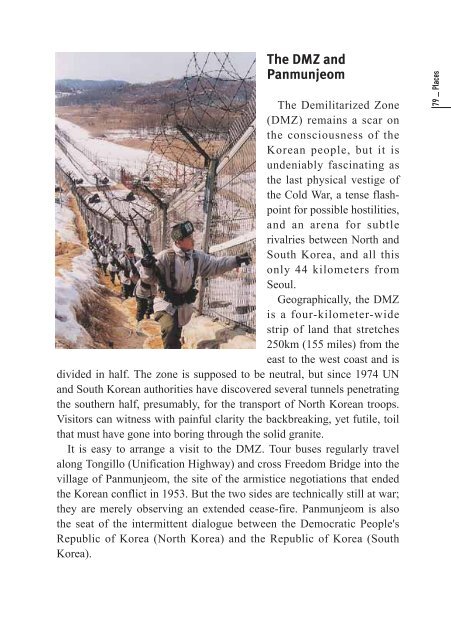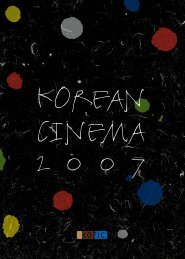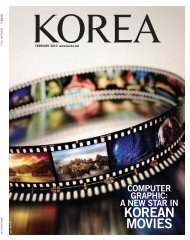HELLO from KOREA
Hello-Eng(3.3) - Korea.net
Hello-Eng(3.3) - Korea.net
- No tags were found...
You also want an ePaper? Increase the reach of your titles
YUMPU automatically turns print PDFs into web optimized ePapers that Google loves.
The DMZ and<br />
Panmunjeom<br />
The Demilitarized Zone<br />
(DMZ) remains a scar on<br />
the consciousness of the<br />
Korean people, but it is<br />
undeniably fascinating as<br />
the last physical vestige of<br />
the Cold War, a tense flashpoint<br />
for possible hostilities,<br />
and an arena for subtle<br />
rivalries between North and<br />
South Korea, and all this<br />
only 44 kilometers <strong>from</strong><br />
Seoul.<br />
Geographically, the DMZ<br />
is a four-kilometer-wide<br />
strip of land that stretches<br />
250km (155 miles) <strong>from</strong> the<br />
east to the west coast and is<br />
divided in half. The zone is supposed to be neutral, but since 1974 UN<br />
and South Korean authorities have discovered several tunnels penetrating<br />
the southern half, presumably, for the transport of North Korean troops.<br />
Visitors can witness with painful clarity the backbreaking, yet futile, toil<br />
that must have gone into boring through the solid granite.<br />
It is easy to arrange a visit to the DMZ. Tour buses regularly travel<br />
along Tongillo (Unification Highway) and cross Freedom Bridge into the<br />
village of Panmunjeom, the site of the armistice negotiations that ended<br />
the Korean conflict in 1953. But the two sides are technically still at war;<br />
they are merely observing an extended cease-fire. Panmunjeom is also<br />
the seat of the intermittent dialogue between the Democratic People's<br />
Republic of Korea (North Korea) and the Republic of Korea (South<br />
Korea).<br />
79 _ Places
















